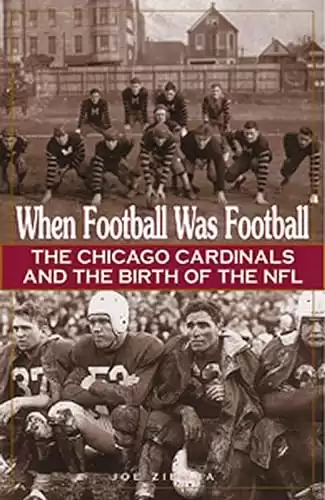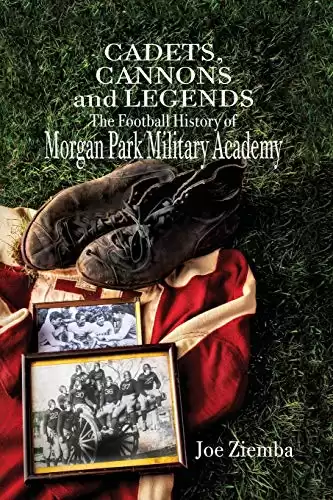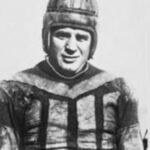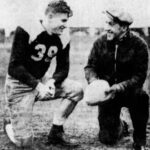We recently learned of the passing of Charley Trippi, one of the most versatile players ever to play the game of football. Trippi was 100 years old and left us with decades of accomplishments, memories, and stories.
Perhaps the best recollection, in my humble opinion, was a run that Trippi of the Chicago Cardinals made in the 1947 NFL championship game against the Philadelphia Eagles. Working on a frozen field at Chicago’s Comiskey Park, the Cardinals switched to gym shoes before the game in an effort to secure better traction on the unforgiving turf.

Trippi scored twice that day to lead the Cardinals to a 28-21 victory over the Eagles, but it was his dazzling performance on a punt return that left the Philadelphia defenders in a shambles. How bad was the field you may ask? Reporter Art Daley of the Green Bay Gazette wrote: “They [the players] staggered around like 22 drunken men in a dark alley!”
The Cardinals were protecting a 14-7 lead midway through the third period when Trippi went back to field a punt on his own 25 as described by Frank O’Gara of the Philadelphia Inquirer: “Trippi picked it up as it bounced around on the Cardinals’ 25, and when he battered the first cordon of off-balanced tacklers, there were not many green jerseys in his path.
He was hit three more times as he wheeled down the field, but nobody could smack him solidly. Once in the clear, Charley himself slipped on the Eagles
25 as he tried to cut back behind the final block, but scrambled up and raced across. It was now 21-7 and everyone expected the Eagles to give up peacefully.”
Witnesses would later tell how Trippi zig-zagged across the field to elude would-be tacklers. Apparently, this prompted Philadelphia coach Greasy Neale to yell out to his players: “Get up and be ready. He’ll be coming back this way any second now!”
Trippi was an elusive runner, mastering hip and shoulder fakes to partner with his quickness to frustrate the opposition. And yet, at 6-0 and 185, Trippi could also turn into a battering ram, often putting his head down into the defender before the opponent could lock up his legs. Still, there was more: Trippi was an ace defensive back, a punter, a passer, a receiver, and a kick return man—all of which he did exceptionally well.
Trippi's High School Career
However, Trippi’s successful football career almost ended before it started. The son of a miner in Pittston, PA, Trippi was born on December 14, 1921. While on the football team at Pittston High School, Trippi was not considered for his offensive capabilities and was anchored in the middle of the line as a center.
He also handled punting duties for the team, but it was as a punter that the legend of Charley Trippi, the offensive juggernaut, was born.
As the 16-year-old Trippi waited for the snap one game, the ball flew well over his head where he hustled back and picked it up on his own 14. Displaying a bit of the verve and misdirection he would later be known for, Trippi picked his way through the defense and scrambled 86 yards for the score as Pittston escaped with a 7-6 victory!
By his senior year in 1939, Trippi was all over the place. For example, in a 32-0 rout of Forty Fort High School, Trippi threw for two scores, ran for another, and nearly scored another on an interception return.
Trippi Heads To Georgia
It wasn’t long before Trippi’s talents were discovered by the next level and he found his way down to the University of Georgia after a year of prep school. Trippi secured his varsity debut for the Bulldogs in the fall of 1942 and made an immediate impact.
During spring practice, he was eagerly compared to his talented teammate, Frank Sinkwich, an All-American. Between the two dazzling backs, Georgia marched all the way to the 1943 Rose Bowl where Trippi was named the MVP as Georgia ousted UCLA 9-0 and finished with an 11-1 record.
Trippi rushed for 115 yards and passed for another 161. UCLA Coach Babe Horrell was amazed at the performance of Trippi and told reporters after the game: “This boy Trippi was really hot. We just couldn’t seem to get him nailed down.”
The Georgia duo of Sinkwich and Trippi was deadly and years later, Trippi described how their talents offset each other: “I was hard to defend because I improvised a lot. I’d start one way, then go the other way. I was a scrambler. Frank was a tough inside runner. When I played with him in the backfield, they’d pack it in to stop him, and that would open the outside for me.”
With Sinkwich gone in 1943, Trippi was expected to stretch his legs as the returning star of the Bulldogs. However, he was called to military service in the spring of 1943 and stationed at the Greensboro (NC) Army Air Forces Basic Training Center. Trippi was in the service until late in the 1945 season when he returned to Georgia, much to the delight of coach Wally Butts who said:
“Three years in the service has not done Trippi a bit of harm.” Trippi played football for two seasons while in the military and was in remarkable shape when he returned home, but was soon faced with a tough decision.

#1 Overall Draft Pick Stays In School
In April of 1945, Trippi was selected by the Chicago Cardinals as the overall NFL number one draft pick, but the exquisite gridder had already decided on his immediate future: “I promised myself the day I left that, no matter how long the war or how much money the pros offered me, I would come back to Georgia and finish the career I had started.”
With that decision in place, the Cardinals would need to wait to claim their top choice until Trippi was ready. Trippi topped Georgia in rushing and passing in 1945 despite playing in just six contests as the Bulldogs finished 9-2 and won the Oil Bowl over Tulsa 20-6. For his efforts, Trippi was named to the All-Southeastern Conference honor team, but for Trippi, the best was yet to come.
In 1946, Trippi led Georgia to an undefeated season with an 11-0 record, and the national title, including a 20-10 win over North Carolina in the Sugar Bowl. Trippi paced his team in both rushing and passing and was named as a first-team All-American and won the Maxwell Award given to the most outstanding player in the country.
At one time, he held the SEC record for most yards passing (323) and rushing (239 yards) in a single game. In the spring, he dominated the stat sheet for the Georgia baseball team, hitting .475 and blasting 11 homers. Several major league baseball clubs were now in pursuit of Trippi’s skills as well as their NFL brethren.
Upon his departure from Georgia, Trippi was now free to pursue professional sports and spent the summer of 1947 hitting .334 for the minor league Atlanta Crackers. In addition, a new professional football league called the All-America Football Conference looked to actively chase Trippi, who now could choose between two professional football leagues and several major league baseball teams.
In early 1947, Cardinals’ owner Charles Bidwill actually traveled with Trippi to New York where the young star could listen to the confident pitches from both the New York Yankees baseball team and the New York Yankees football club from the All-America Conference. While the public anxiously awaited Trippi’s decision, Bidwill’s hard work in recruiting paid off:
Trippi had already secretly agreed to a huge contract to play football for the Chicago Cardinals! Cardinals coach Jimmy Conzelman was amused by the feint thrown by Bidwill and Trippi in the negotiations: “Bidwill had already bagged Trippi while Dan Topping [the New York owner] was putting on his hunting jacket and practicing bird calls.” In this case, the prized bird named Charley Trippi had already flown to Chicago!
Monster Contract & Dream Backfield
Trippi signed with the Cards for a whopping $100,000 over four years and quickly became part of the team’s “Dream Backfield” the first time an NFL squad started four college All-Americans. Trippi joined fullback Pat Harder (Wisconsin), quarterback Paul Christman (Missouri), and halfback Marshall Goldberg (Pittsburgh). Later, Goldberg switched to defense and was replaced by Elmer Angsman of Notre Dame.
With Trippi in the fold, the Cardinals won the 1947 NFL title with that 28-21 victory over the Philadelphia Eagles. Of course, Trippi tallied two touchdowns to help secure that victory. In 1948, the Cardinals were even better, finishing the regular season with an 11-1 record, but fell 7-0 in blizzard conditions to those same pesky Eagles in the NFL championship game held in Philadelphia.
While the Cardinals have not managed to secure another NFL crown since the Trippi-led squad won it all in 1947, Trippi continued to contribute on all levels for the team. After All-Pro seasons in 1947 and 1948 primarily as a halfback, Trippi expanded his role as a receiver in 1949, rushing for 554 yards while topping the team in receptions with 32.
Then in 1951, Cards’ coach Curly Lambeau moved Trippi to quarterback and the former Bulldog was named to the Pro Bowl at that position. Trippi remained a force as a defensive back as well, picking up three interceptions in 1954 and averaged over 40 yards a punt during his professional career.
When Trippi retired after the 1955 campaign, his 6,053 total yards (rushing, passing, receiving) were the best in NFL history up to that point. In fact, his total of all-purpose yards (7,148) was the fourth best in history.

Charley Trippi - Hall of Fame Career
It was no surprise when Charley Trippi was elected to the Professional Football Hall of Fame in 1968 following his selection to the College Football Hall of Fame in 1959. It is interesting to discover just how versatile Trippi was as an NFL player. Apparently, there are now 362 players in the Pro Football Hall of Fame, but there are none, absolutely none, who have picked up at least 1,000 yards rushing, 1,000 yards passing, and 1,000 yards receiving—except for one man: Charley Trippi…
We could go on and on about Charley Trippi from up here in the press box at old Comiskey Park. We could talk about how Trippi played in an unprecedented five College All-Star football games; or how he was twice an All-American among service team players during WWII; or how he coached in the NFL for several years with the Cardinals; or how he was successful in real estate after his playing career concluded; or how his high school stadium in Pittston, PA was named after him in 1970.
At that time, the Scrantonian newspaper reported: “A number of times since he attained greatness beyond that of any other Pittstonian, Trippi has returned to community receptions. None approached this one. If only because this section where he first dreamed of greatness as a boy, had bestowed upon him an eternal honor by renaming the field where the touchdown troupes of the tomorrows would preserve Pittston’s reputation.”
We will miss you Charley Trippi and thank you for your many successes and memories which will never be forgotten. Please join us next time on “When Football Was Football” where we’ll discuss an exhibition game that pitted George Halas against First Lady Eleanor Roosevelt. How in the world did that happen? We’ll share that story next–here on the Sports History Network!
Author and Host - Joe Ziemba
Joe Ziemba is the host of this show, and he is an author of early football history in the city of Chicago. Here, you can learn more about Joe and When Football Was Football, including all of the episodes of the podcast.
Please Note – As an Amazon Associate I earn from qualifying purchases
Resources
More From When Football Was Football
Paddy Driscoll’s Almost Perfect Season
Back at the beginning of the National Football League in...
Read More120,000 Fans Witness High School Football Game in 1937!!!
Let’s set the stage… It was a warm November afternoon...
Read MoreIn The Beginning: An Interview With Joseph T. Sternaman
And, you may ask, who is Joseph T. Sternaman? Sternaman...
Read More1948: The Last Hurrah of the Chicago Cardinals
Cardinals’ fans are familiar with the long, sad story concerning...
Read More




